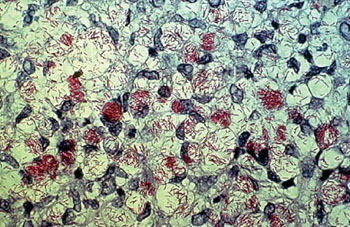Molecular-Based Techniques Diagnose Leprosy
By LabMedica International staff writers
Posted on 23 Apr 2014
The classic tools to diagnose leprosy are based on bacillary counts and histopathology, but these have been facing hurdles, especially in distinguishing latent infection from active disease and diagnosing paucibacillary clinical forms.Posted on 23 Apr 2014
Serological tests and interferon gamma (IFN-γ) releasing assays (IGRA) that employ humoral and cellular immune parameters, respectively, are also being used, but recent results indicate that quantitative polymerase chain reaction (qPCR) is a key technique due to its higher sensitivity and specificity.

Image: A photomicrograph of Mycobacterium leprae, the small brick-red rods, taken from a leprosy skin lesion (Photo courtesy of Centers of Disease Control and Prevention).
Scientists at the Instituto Oswaldo Cruz (Rio de Janeiro, Brazil) have evaluated the various molecular assays now being used to detect Mycobacterium leprae, the causative agent of leprosy. Advances concerning the structure and function of the M. leprae genome led to the development of specific PCR-based gene amplification assays for leprosy diagnosis and monitoring of household contacts.
Some of their findings suggest that commercial kits can be used to extract, purify and amplify M. leprae DNA, ribonucleic acid (RNA), or both. Samples can also be easily stored in 70% ethanol and fast technology for analysis of nucleic acids (FTA) cards (Whatman, Maidstone, UK) for M. leprae DNA detection. Irrespective of whether the detection method used is conventional or real-time PCR, smaller PCR products allow for better amplification efficiency from DNA extracted from either formalin- or ethanol-fixed or fresh tissues. In fact, an important advance has been the real-time PCR technology.
While PCR diagnosis is not needed for lepromatous patients with high bacillary load and high number of lesions, it is extremely helpful for the diagnosis of the situations such as clinical presentations with scarce number of M. leprae bacilli (paucibacillary) and difficult-to-diagnose patients. The detection of M. leprae DNA in different samples of the household contacts of leprosy patients is very promising. Although a positive PCR result is not sufficient to establish a causal relationship with disease outcome, quantitation provided by qPCR is clearly capable of indicating increased risk of developing the disease and could alert clinicians to follow these contacts more closely or even define rules for chemoprophylaxis.
The authors concluded that overall, extensive evaluation of PCR tests in field studies has shown that DNA-based PCR assays can be 100% specific, while the sensitivity ranges from 34% to 80% in patients with paucibacillary forms to greater than 90% in patients with multibacillary forms of the disease. PCR has been ascertained to be especially valuable in diagnosing difficult cases like pure neural leprosy, paucibacillary, and patients with atypical clinical presentation and histopathological features compatible with leprosy. The study was published on April 10, 2014, in the journal Public Library of Science Neglected Tropical Diseases.
Instituto Oswaldo Cruz
Whatman
Related Links:













